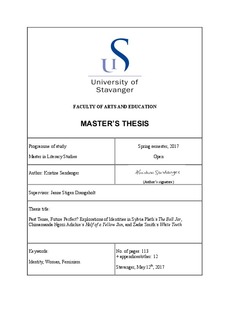Past Tense, Future Perfect? Explorations of Identities in Sylvia Plath´s The Bell Jar, Chimamanda Ngozi Adichie´s Half of a Yellow Sun, and Zadie Smith´s White Teeth
Master thesis
Permanent lenke
http://hdl.handle.net/11250/2446919Utgivelsesdato
2017-05-12Metadata
Vis full innførselSamlinger
- Student papers (HF-IKS) [884]
Sammendrag
Socially constructed ideas about what it means to be female affect women today, as they always have. Throughout history, these ideas have manifested themselves through expectations and demands that women should conform to in order to be considered feminine. This thesis seeks to investigate the manners in which these expectations affect women´s sense of self. Because one´s sense of self-worth and identity is in many ways connected to the feeling of acceptance, identification and belonging in one´s contemporary society, it will be investigated how social conventions and demands affect women´s construction of a stable sense of self, and particularly the challenges that arise for those who may not wish, or are unable to conform to accordingly. This is an important topic, because we are not only dealing with a historical phenomenon, but a universal problem that still exists today, namely the idea that women should fit into a certain mold in order to be considered women.
I will conduct a comparative analysis of three novels and investigate how the main female character in each of these struggles to construct her identity as a woman either in concord or conflict with her contemporary society, and to what degree this affects her development of selfhood. Furthermore, this thesis will deal with the beauty ideal, because the identity of a woman warrants that the female human being conforms to certain standards of beauty. The characters and novels that will be investigated are Esther Greenwood in Sylvia Plath´s The Bell Jar (1966), Olanna Ozobia in Chimamanda Ngozi Adichie´s Half of a Yellow Sun (2014a), and finally, Irie Ambrosia Jones in Zadie Smith´s White Teeth (2000). These female characters are connected in that they are all attempting to find out who they are as women in their contemporary societies. Either directly or indirectly, they are asking themselves the question “who am I?” and attempt to find their place in this world.
Beskrivelse
Master's thesis in Literacy studies
